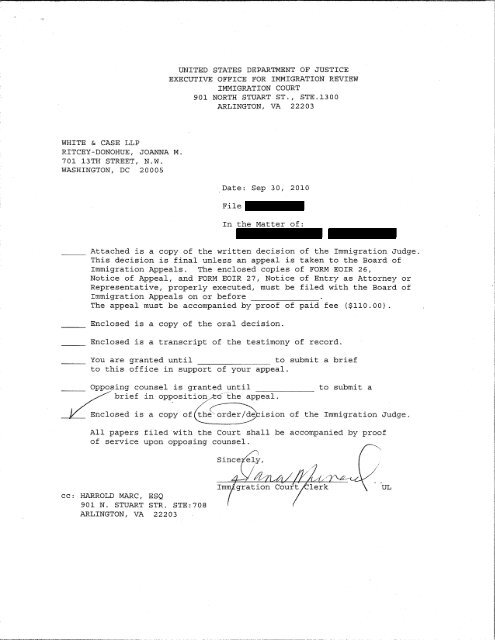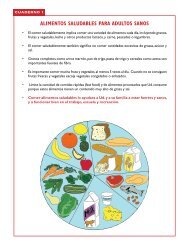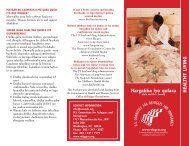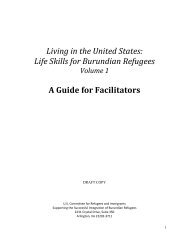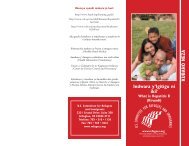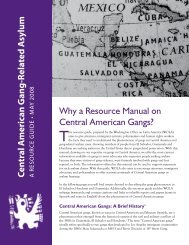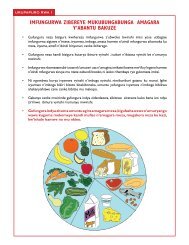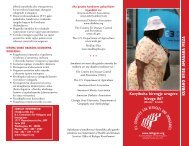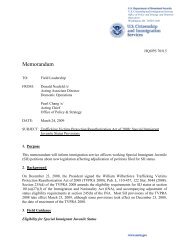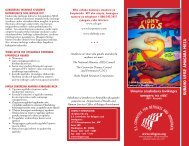Immigration Appeals. The enclosed copies of FORM EOIR 26
Immigration Appeals. The enclosed copies of FORM EOIR 26
Immigration Appeals. The enclosed copies of FORM EOIR 26
Create successful ePaper yourself
Turn your PDF publications into a flip-book with our unique Google optimized e-Paper software.
UNITED STATES DEPARTMENT OF JUSTICE<br />
EXECUTIVE OFFICE FOR IMMIGRATION REVIEW<br />
IMMIGRATION COURT<br />
901 NORTH STUART ST., STE.1300<br />
ARLINGTON, VA 22203<br />
WHITE & CASE LLP<br />
RITCEY-DONOHUE, JOANNA M.<br />
701 13TH STREET, N.W.<br />
WASHINGTON, DC 20005<br />
.Date: Sep 30, 2010<br />
File<br />
In the Matter <strong>of</strong>:<br />
Attached is a copy <strong>of</strong> the written decision <strong>of</strong> the <strong>Immigration</strong> Judge.<br />
This decision is final unless an appeal is taken to the Board <strong>of</strong><br />
<strong>Immigration</strong> <strong>Appeals</strong>. <strong>The</strong> <strong>enclosed</strong> <strong>copies</strong> <strong>of</strong> <strong>FORM</strong> <strong>EOIR</strong> <strong>26</strong>,<br />
Notice <strong>of</strong> Appeal, and <strong>FORM</strong> <strong>EOIR</strong> 27, Notice <strong>of</strong> Entry as Attorney or<br />
Representative, properly executed, must be filed with the Board <strong>of</strong><br />
<strong>Immigration</strong> <strong>Appeals</strong> on or before<br />
<strong>The</strong> appeal must be accompanied by pro<strong>of</strong> <strong>of</strong> paid fee ($110.00).<br />
Enclosed is a copy <strong>of</strong> the oral decision.<br />
Enclosed is a transcript <strong>of</strong> the testimony <strong>of</strong> record.<br />
You are granted until<br />
to submit a brief<br />
to this <strong>of</strong>fice in support <strong>of</strong> your appeal.<br />
_____ Opposing counsel is granted until<br />
to submit a<br />
Z<br />
brief in opposition ___ A:06"the appeal.<br />
, //<br />
Enclosed is a copy <strong>of</strong>~~der~ision <strong>of</strong> the <strong>Immigration</strong> Judge.<br />
All papers filed with the Court shall be accompanied by pro<strong>of</strong><br />
<strong>of</strong> service upon opposing counsel.<br />
--~~~~~~+'~IL:~:~~~~~~~UL<br />
cc: HARROLD MARC, ESQ<br />
901 N. STUART STR. STE:708<br />
ARLINGTON, VA 22203
UNITED STATES DEPARTMENT OF JUSTICE<br />
EXECUTIVE OFFICE FOR IMMIGRATION REVIEW<br />
United States <strong>Immigration</strong> Court<br />
901 North Stuart Street, Suite 1300<br />
Arlington, VA 22203<br />
IN THE MATTER OF: )<br />
)<br />
)<br />
)<br />
Respondent )<br />
)<br />
IN REMOVAL PROCEEDINGS<br />
File No.<br />
CHARGE:<br />
APPLICATIONS:<br />
Section 212(a)(6)(A)(i) <strong>of</strong> the <strong>Immigration</strong> and Nationality Act ("INA" or<br />
"Act"), as amended, as an alien who is present in the United States without<br />
being admitted or paroled, or who arrived in the United States at any time or<br />
place other than as designated by the Attorney General.<br />
Asylum, pursuant to INA § 208(a) and Withholding <strong>of</strong> Removal, pursuant to<br />
INA § 241(b)(3).<br />
APPEARANCES<br />
FOR THE RESPONDENT:<br />
Joanna M. Ritcey-Donohue, Esq.<br />
White & Case LLP ,<br />
701 13 th Street, N.W.<br />
Washington, D.C. 20005<br />
FOR THEDHS:<br />
Marc M. Harrold, Esq.<br />
Assistant Chief Counsel<br />
Department <strong>of</strong> Homeland Security<br />
901 North Stuart Street, Suite 708<br />
Arlington, V A 22203<br />
DECISION AND ORDER<br />
I. BACKGROUND<br />
<strong>The</strong> respondent is a male and a native and citizen <strong>of</strong> EI Salvador. He entered the United<br />
States without admission or parole on or about . On the<br />
Department <strong>of</strong> Homeland Security ("DHS" or "Government") filed a notice to appear ("NT A") with<br />
the immigration court, charging the respondent under INA § 212(a)(6)(A)(i). <strong>The</strong> respondent has<br />
admitted the allegations and conceded the charge <strong>of</strong> inadmissability contained in the NT A. See Exh.<br />
2. He applies for the relief <strong>of</strong> asylum, pursuant to INA § 208(a) and withholding <strong>of</strong> removal,<br />
pursuant to INA § 241(b)(3). For the reasons that follow, the court will grant the respondent's<br />
application for asylum and does not reach his application for withholding <strong>of</strong> removal under the Act.<br />
1
II. STATEMENT OF LAW<br />
<strong>The</strong> <strong>Immigration</strong> and Nationality Act, as amended by the REAL ID Act <strong>of</strong>2005, governs this<br />
case because the respondent initially filed Fonn 1-589 on or after May 11,2005. See Matter <strong>of</strong>S-B-,<br />
24 I&N Dec. 42 (BIA 2006). <strong>The</strong> respondent has the burden <strong>of</strong> pro<strong>of</strong> on the applications. See 8<br />
C.F.R. § 1208.13(a); see also INSv. Cardoza-Fonseca, 480 U.S. 421,435 (1987). In this respect,<br />
the respondent's credibility is very important and may be detenninative. Generally, the respondent<br />
must testify in detail, plausibly, and consistently. INA § 240(c)(4)(c). <strong>The</strong> respondent should<br />
satisfactorily explain any material discrepancies or omissions. Id.<br />
<strong>The</strong> court may grant an application solely on the basis <strong>of</strong> credible testimony. However, it<br />
may also choose to require corroborating evidence where that evidence is reasonably available. <strong>The</strong><br />
respondent must provide corroboration to bolster an otherwise unconvincing claim. See Matter <strong>of</strong><br />
S-M-J-, 21 I&N Dec. 722 (BIA 1997). A respondent who does not <strong>of</strong>fer such reasonably available<br />
corroborating evidence generally should explain the failure to do so. Id. But, according to the Board<br />
<strong>of</strong><strong>Immigration</strong> <strong>Appeals</strong> ("Board"), the court cannot base an adverse credibility ruling solely on the<br />
respondent's failure to provide corroboration. Matter <strong>of</strong> L-K-, 23 I&N Dec. 677, 682 (BIA 2004).<br />
In accordance with circuit law, even in cases where the respondent presents his claim in a<br />
manner that prompts adverse credibility findings, the record as a whole should be evaluated to<br />
detennine whether independent evidence establishes the respondent's claims. See Camara v.<br />
Ashcr<strong>of</strong>t, 378 F.3d 361 (4th Cir. 2004). However, the Fourth Circuit has clarified that affidavits<br />
from friends and family are not the independent evidence on the record that Camara contemplates.<br />
See Gandziami -Mickhou v. Gonzales, 445 F.3d 351 (4th Cir. 2006).<br />
In making credibility detenninations, courts consider the totality <strong>of</strong> the circumstances and<br />
all relevant factors. Courts may base a credibility detennination on the respondent's or witness's<br />
demeanor, candor, or responsiveness, as well as the inherent plausibility <strong>of</strong> the account. INA<br />
§ 208(b)(1 )(B)(iii).<br />
To be eligible for asylum, the respondent must show that he is unwilling or unable to return<br />
to EI Salvador because <strong>of</strong> persecution or an objectively reasonable fear <strong>of</strong> persecution on account<br />
<strong>of</strong>race, religion, nationality, membership in a particular social group, or political opihion. 8 C.F.R.<br />
§ 1208.13(b).<br />
Under the regulations, if the respondent establishes past persecution, the court must presume<br />
the respondent's future persecution unless the government proves that fundamentally changed<br />
circumstances or a reasonably available internal relocation alternative have eliminated that<br />
individualized fear. 8 C.F.R. § 1208. 13(b)(1 )(ii)( emphasis added). However, if the respondent does<br />
not prove past persecution, the regulations place the burden on him to show that there is no<br />
reasonably available internal relocation in EI Salvador unless the feared persecution is by the<br />
government or government-sponsored. 8 C.F.R. § 1208.13(b)(1)(i).<br />
2
A well-founded fear <strong>of</strong> persecution must be both subjectively genuine and objectively<br />
reasonable. See Cardoza-Fonseca, 480 U.S. at 430-31. To demonstrate a subjective fear <strong>of</strong><br />
persecution, an applicant must demonstrate a genuine apprehension <strong>of</strong> awareness <strong>of</strong> the risk <strong>of</strong><br />
persecution. See Matter <strong>of</strong> Acosta, 19 I&N Dec. at 221. <strong>The</strong> objective component requires a showing<br />
by credible, direct, and specific evidence in the record that the alien's fear <strong>of</strong> persecution is<br />
reasonable. See De Valle v. INS, 901 F.2d 787, 790 (9th Cir. 1990).<br />
To qualify for withholding <strong>of</strong> removal under INA § 241 (b )(3), the respondent must show that<br />
he more likely than not will be persecuted in EI Salvador on account <strong>of</strong>race, religion, nationality,<br />
membership in a particular social group, or political opinion. See 8 C.F.R. § 1208.16(b).<br />
<strong>The</strong> respondent can establish the nexus for asylum and withholding under the Act by showing<br />
directly or indirectly that the past persecution or feared future persecution is, at least in part, on<br />
account <strong>of</strong>a protected ground. See Matter <strong>of</strong>S-P-, 21 I&N Dec. 486 (BIA 1996).<br />
A. <strong>The</strong> Respondent's Testimony<br />
III. TESTIMONY AND EVIDENCE<br />
<strong>The</strong> respondent is twenty- years old. He was born in EI Salvador. He came to the<br />
United States through EI Paso, Texas on at the age <strong>of</strong> seventeen. He currently lives<br />
with .<br />
<strong>The</strong> respondent testified that he came to the United States because Mara 18 killed his brother,<br />
, and then began threatening him. He said that two leaders <strong>of</strong> Mara 18,<br />
paid other members <strong>of</strong> that gang to kill whom they suspected was a member <strong>of</strong> the rival<br />
gang Mara Salvatrucha ("MS 13 "). is the respondent's cousin. <strong>The</strong> respondent said that they<br />
learned who killed from a private investigator who his father hired after death.<br />
<strong>The</strong> respondent stated that was stabbed to death See Exh. 8, Tab F.<br />
After death, the respondent learned from his mother that was always<br />
"making trouble" for because <strong>of</strong> girls and soccer and because he believed that was<br />
a member <strong>of</strong> MS 13. He said that wanted to join Mara 18 but that<br />
refused. <strong>The</strong> respondent testified that wanted to go to the United States because<br />
he was afraid that he would be killed, but that his mother did not permit him to leave. was<br />
fifteen years old when he was killed. <strong>The</strong> respondent said that the police did not do anything to<br />
apprehend his brother's killers.<br />
<strong>The</strong> respondent was eleven years old when was killed. He said that the gang began<br />
threatening him after his brother's death. He stated that his hometown was controlled by Mara 18<br />
but that he played soccer in an area that was controlled by MS l3. <strong>The</strong> respondent testified that<br />
thought that he was a member <strong>of</strong> MS 13 because he entered into MS 13 territory<br />
3
to play soccer. On cross-examination, the respondent stated that even though the Mara 18 suspected<br />
him <strong>of</strong> belonging to MS 13, they did not kill him because they were trying to recruit him.<br />
<strong>The</strong> respondent provided some specific examples <strong>of</strong> Mara 18 threatening him. On one<br />
occasion, when he was fifteen years old, the respondent was with his school friends when<br />
pulled a knife on him, demanded money and asked him to join the gang. On another<br />
occasion, he said that<br />
stopped him while he was riding his bicycle to the soccer<br />
field. <strong>The</strong>y accused him <strong>of</strong> belonging to MS 13 and said that ifhe refused to join Mara 18 he would<br />
experience the same fate as his brother <strong>The</strong> respondent testified that he never reported<br />
these threats to the police because if the gang found out that he had filed a report they would have<br />
hurt him or his family.<br />
<strong>The</strong> respondent said that the gang has also threatened his family. After death, the<br />
respondent's uncle received a letter threatening to bomb his family'S house. See Exh 5, Tabs 2,3.<br />
On cross-examination, the respondent said that members <strong>of</strong> Mara 18 gave the letter directly to his<br />
uncle. He said that his family did not report the bomb threat to the police because the police are<br />
corrupt and would not have done anything.<br />
<strong>The</strong> respondent testified that he is afraid to return to EI Salvador because he believes that the<br />
gangs will find him and "eliminate" him. He said that is still living in the same neighborhood<br />
as his family and that Mara 18 still operates in that area. He stated that the threats to his family<br />
stopped after he left EI Salvador. According to the respondent, the gangs operate throughout all <strong>of</strong><br />
EI Salvador and he would be unable to live safely in another location. He said that a friend who used<br />
to live in returned to El Salvador and was killed six months later by Mara 18.<br />
B. Expert Testimony <strong>of</strong><br />
<strong>The</strong> expert witness testified that he submitted an affidavit. See Exh. 10, Tab C. Based on his<br />
knowledge <strong>of</strong> gangs in EI Salvador he said that the respondent's affidavit is consistent with country<br />
conditions in EI Salvador:<br />
He stated that from 1998-2004, gang activity and gang violence was increasing in EI Salvador<br />
because <strong>of</strong> warfare between the rival gangs <strong>of</strong> Mara 18 and MS 13. Young men from the ages <strong>of</strong><br />
eleven to nineteen were <strong>of</strong>ten targeted for gang recruitment. He added that although the respondent<br />
is now twenty years old, he would still be at risk <strong>of</strong> gang recruitment if returned to EI Salvador<br />
because the average age <strong>of</strong> gang members has increased. He stated that gang recruitment has became<br />
more selective because <strong>of</strong> increased governmental pressure on gangs and stronger ties between gangs<br />
and drug cartels.<br />
On cross-examination, the expert witness testified that the gangs were very territorial and that<br />
if a gang member came into contact with a rival gang member violence generally ensued. On<br />
redirect examination, he stated that if a gang member encountered an individual who he only<br />
suspects <strong>of</strong> being in another gang, he might simply threaten the other individual or attempt to recruit<br />
4
------------ ------~.--~-<br />
-<br />
him. He testified that if a gang has killed an individual, they will also target a family member who<br />
would be most likely to retaliate for that death, particularly a young male who lived in the household<br />
<strong>of</strong> the deceased individual. He explained that gangs have a "collective memory," meaning that<br />
incidents involving individuals considered to be a gang's enemies are passed on to newer gang<br />
members and are not forgotten even after many years.<br />
According to the expert witness, law enforcement is unable to control the gangs in EI<br />
Salvador. He stated that the homicide rate in EI Salvador is the highest in the Western Hemisphere<br />
and that gang violence contributes to the high homicide rate. He opined that the Salvadoran<br />
government is neither competent nor effective in controlling crime or protecting the general<br />
population from crime. He said that victims <strong>of</strong> gang violence <strong>of</strong>ten do not report criminal incidents<br />
to the police because they fear that the authorities will not protect them. He testified that there is<br />
corruption within the police force and that some police <strong>of</strong>ficers are gang members. He stated that<br />
more recently, reports have been made that gangs have obtained grenades and other explosives from<br />
the police and the military in EI Salvador.<br />
<strong>The</strong> expert witness said that the gangs extort money from individuals in gang-controlled<br />
territories. He stated that the respondent would most likely be targeted for extortion ifhe returned<br />
to EI Salvador. He also stated that the respondent might be a target <strong>of</strong> gang violence because <strong>of</strong> his<br />
brother's death and his own refusal to join the gang.<br />
He testified that based upon his experience, he believes that the respondent would be in<br />
danger ifhe returns to EI Salvador. He said that a gang keeps informal registries <strong>of</strong> its enemies and<br />
that individuals who were targeted by a gang and then return to that gang's territory even five to ten<br />
years later have been killed.<br />
C. the Respondent's Sister<br />
<strong>The</strong> witness stated that the respondent is her brother. She said that she never knew him to<br />
be a member <strong>of</strong> a gang. 'She came to the United States in She said that she was not in EI<br />
Salvador when was killed. She said that she did not believe that was in a gang.<br />
She said that her mother told her that was killed by a gang member.<br />
<strong>The</strong> witness has returned to EI Salvador once for three weeks in She visited<br />
grave site in EI Salvador and said that the cement marker on grave had been scratched,<br />
a cement cross was broken, and some flowers that she had left were taken. She testified that she was<br />
not threatened by when she returned to EI Salvador. She added that she went out only a few<br />
times during her visit.<br />
<strong>The</strong> witness stated that would pose a threat to the respondent's safety if he returned<br />
to EI Salvador. She said that approximately families live in her hometown. She testified that<br />
the respondent would be conspicuous if he returned to their hometown.<br />
5
D. Documentary Evidence<br />
<strong>The</strong> record includes the respondent's NTA, filed<br />
(Exhibit 1); the<br />
respondent's motion for change <strong>of</strong> venue, waiver <strong>of</strong> appearance, motion to withdraw, filed<br />
(Exhibit 2); the respondent's Form 1-589, Application for Asylum and for Withholding <strong>of</strong><br />
Removal, filed<br />
(Exhibit 3); country conditions reports and news articles in<br />
support <strong>of</strong> the respondent's asylum application, with Tabs 1-29 (Group Exhibit 4); brief in support<br />
<strong>of</strong> the respondent's asylum application, with Tabs 1-25 (Group Exhibit 5); supplemental brief and<br />
exhibits, with Tabs A-O (Group Exhibit 6); United States Department <strong>of</strong> State Issue Paper: Youth<br />
Gang Organizations in EI Salvador (Exhibit 7); second supplemental brief and exhibits, with Tabs<br />
A-P (Group Exhibit 8); third supplemental brief and exhibits, with Tabs A- H, filed<br />
(Group Exhibit 9); revised witness list (Exhibit 10); and fourth supplemental brief and exhibits, with<br />
Tabs A-D (Group Exhibit 11).<br />
A. Application/or Asylum<br />
1. One-Year Deadline<br />
IV. FINDINGS AND ANALYSIS<br />
<strong>The</strong> respondent arrived in the United States on<br />
See Exh. 1. He filed his<br />
asylum application on<br />
Although the respondent did not file his asylum<br />
application within one year <strong>of</strong> his arrival in the United States, the court finds that extraordinary<br />
circumstances excuse his failure to do so.<br />
<strong>The</strong> respondent entered the United States as an unaccompanied minor and turned eighteen<br />
on<br />
. See Exh. 3 at 8 (explaining that the respondent's age contributed to the filing <strong>of</strong><br />
his asylum application after the one year deadline). This constitutes extraordinary circumstances as<br />
defined by the regulations. See 8 C.F.R. § I208.4(a)(5)(ii) (2010). He filed his asylum application<br />
approximately six months after turning eighteen years <strong>of</strong> age. <strong>The</strong> court finds that this was a<br />
reasonable period <strong>of</strong> time in which to file his asylum application given his extraordinary<br />
circumstances. See 8 C.F.R. § I208.4(a)(5). DHS does not allege that the respondent's asylum<br />
application is time barred.<br />
Accordingly, the court finds that the respondent has demonstrated extraordinary<br />
circumstances excusing his failure to file his asylum application within a year <strong>of</strong> his arrival in the<br />
United States and that he is therefore eligible to pursue asylum relief. See INA § 208(a)(2)(B), (D).<br />
6
------------ ------------<br />
2. Credibility and Corroboration<br />
a. <strong>The</strong> Respondent<br />
After considering the totality <strong>of</strong> the circumstances and all relevant factors, the court finds the<br />
respondent credible. See INA § 208(b)(1)(A)(iii). <strong>The</strong> respondent's testimony was internally<br />
consistent and consistent with the written statements contained in his asylum application and<br />
affidavit. See Exh. 3, Group Exh. 5, Tab 1. DHS does not contest the respondent's credibility.<br />
b. Expert Witness<br />
<strong>The</strong> expert witness has extensive experience researching gangs in Central America generally<br />
and El Salvador specifically. Based on this experience, the court finds his testimony regarding gang<br />
behavior and activity in El Salvador to be credible.<br />
c.<br />
After considering the totality <strong>of</strong> the circumstances and all relevant factors, the court finds the<br />
witness credible. Her testimony was internally consistent and consistent with her affidavit. See INA<br />
§ 208(b )(1 )(A)(iii).<br />
3. Past Persecution<br />
<strong>The</strong> respondent claims that he suffered past persecution in El Salvador on account <strong>of</strong> his<br />
membership in a particular social group. <strong>The</strong> court finds that the respondent has demonstrated his<br />
membership in a particular social group, but that he has not demonstrated that the harm he suffered<br />
in El Salvador constitutes persecution.<br />
a. Particular Social Group<br />
<strong>The</strong> respondent alleges that he is a member <strong>of</strong> a particular social group because <strong>of</strong> his familial<br />
relationship to his brother, who was murdered by Mara 18. He articulates the group as<br />
"male siblings <strong>of</strong>those murdered by gangs who resist active recruitment efforts by the same gang."<br />
See <strong>The</strong> Respondent's Third Supplemental Brief in Support <strong>of</strong> the Application for Asylum and<br />
Withholding <strong>of</strong> Removal at 12 (Jan. 8,2010).<br />
<strong>The</strong> Fourth Circuit has recognized that in certain instances family may be a cognizable<br />
particular social group. See Lopez-Soto v. Ashcr<strong>of</strong>t, 383 F.3d 228 (4th Cir. 2004). <strong>The</strong> Board,<br />
however, has held in Matter <strong>of</strong>S-E-G-, 24 I&N Dec. 579, 583 (BIA 2008), that "family members<br />
<strong>of</strong> Salvadoran youth who reject gang membership" does not constitute a particular social group<br />
because the group was not sufficiently particular nor did it possess the requisite socially visibility.<br />
<strong>The</strong> court finds that the facts and record evidence in this case distinguish it from Matter <strong>of</strong>S-E-G-.<br />
7
First, the respondent's proposed particular social group is sufficiently particular because it<br />
is limited to male siblings <strong>of</strong> individuals who have been killed by the gangs and who resist gang<br />
recruitment efforts. <strong>The</strong> expert witness testified that when a gang kills an individual they also target<br />
a male relative <strong>of</strong> the slain individual, particularly a young male who lived in the household <strong>of</strong> the<br />
deceased individual who they believe will be most likely to avenge the death. This differs from the<br />
broad definition <strong>of</strong> family members that was at issue in Matter <strong>of</strong>S-E-G-, 24 I&N Dec. at 585.<br />
Second, the respondent's proposed particular social group is socially visible. In Matter <strong>of</strong><br />
S-E-G-, the Board noted that "there was little in the background evidence <strong>of</strong> record to indicate" that<br />
the proposed particular social group at issue "would be 'perceived as a group' by society, or that<br />
these individuals suffer from a higher incidence <strong>of</strong> crime than the rest <strong>of</strong> the population." 24 I&N<br />
Dec. at 587. In this case, the expert witness testified that male family members <strong>of</strong> those who have<br />
been killed by a gang, particularly young men who lived in the same household as the slain<br />
individual, are specific targets <strong>of</strong> gang violence. <strong>The</strong>re is therefore record evidence indicating that<br />
the members <strong>of</strong> the respondent's proposed particular social group suffer from higher incidents <strong>of</strong><br />
gang violence than the general Salvadoran population.<br />
Additionally, the respondent's sister testified that about families live in their hometown<br />
in EI Salvador. It is therefore a relatively small place and it is reasonable to assume that the<br />
respondent would be known to members <strong>of</strong> his community as sole brother. Furthermore,<br />
one <strong>of</strong> the leaders <strong>of</strong> the local Mara 18, is the respondent's cousin. <strong>The</strong> respondent therefore<br />
also would be known to members <strong>of</strong> Mara 18 as brother as well as an individual who<br />
resisted their recruiting efforts.<br />
Having shown that he is a member <strong>of</strong> a particular social group, the respondent must also<br />
show that the harm that he suffered in EI Salvador constitutes persecution.<br />
b. Harm Rising to the Level <strong>of</strong> Persecution<br />
<strong>The</strong> respondent was never physically harmed by gangs in EI Salvador. He alleges, however,<br />
that the gang's repeated threats and his young age at the time that the threats were made cumulatively<br />
rise to the level <strong>of</strong> persecution. <strong>The</strong> respondent's affidavit indicates that he was frequently harassed<br />
and threatened by members <strong>of</strong> Mara 18 over a period <strong>of</strong> two years. See Group Exh. 5, Tab 1 at 7.<br />
However, in his testimony he identified two specific incidents, one in which members <strong>of</strong> Mara 18<br />
pulled a knife on him and demanded money and another in which they told him that he would face<br />
the same fate as if he refused to join their gang.<br />
Persecution may be found in the absence <strong>of</strong> physical harm so long as the harm is sufficiently<br />
severe. See Mirisawo v. Holder, 599 F.3d 391,396 (4th Cir. 2010). Although the gang's threats<br />
were certainly frightening for the respondent, the court does not find that they were sufficiently<br />
severe to constitute persecution. <strong>The</strong> threats made to the respondent were not imminent. Compare<br />
Setiadi v. Gonzales, 437 F.3d 710, 713 (8th Cir. 2006) (stating that unfulfilled threats <strong>of</strong> physical<br />
injury do not constitute past persecution) and Hernandez-Baena v. Gonzales, 417 F .3d 720, 723 (7th<br />
8
Cir. 2005) (stating that an unfulfilled death threat is not persecution where the threat was not <strong>of</strong> an<br />
immediate and menacing nature) with Nakibuka v. Gonzales, 421 F.3d 473, 477 (7th Cir. 2005)<br />
(finding threats <strong>of</strong> rape constituted past persecution where Respondent was tied up overnight and<br />
soldiers threatened her with a gun and unzipped their pants in her presence).<br />
<strong>The</strong> gang's killing <strong>of</strong> made it more reasonable for the respondent to fear that the<br />
gang would fulfill its threats against him. See Baharon v. Holder, 588 F.3d 228,232-33 (4th Cir.<br />
2009). However, the gang's threats cannot be considered to have been imminent given that they<br />
occurred over a period <strong>of</strong>two years without the respondent ever actually being physically harmed.!<br />
Thus, the court finds that the threats made against the respondent were not sufficiently severe or<br />
imminent to constitute past persecution.<br />
4. Well-Founded Fear <strong>of</strong> Future Persecution<br />
Because the respondent has not established past persecution, he does not benefit from the<br />
presumption <strong>of</strong> future persecution under the regulations. See 8 C.F.R. § 1208.13(b)(1).<br />
For the reasons previously stated, the respondent has shown that he is a member <strong>of</strong> a<br />
particular social group. See supra Part IV.A.3.a. <strong>The</strong> court finds that the respondent's testimony<br />
demonstrates that he possesses a subjectively genuine fear <strong>of</strong> future persecution by the gangs in El<br />
Salvador. Moreover, the record evidence establishes that his fear is objectively reasonable. See<br />
Cardoza-Fonseca, 480 U.S. at 430-31. <strong>The</strong> respondent and his sister testified that continues<br />
to be a member <strong>of</strong> Mara 18 and that the gang continues to operate in their hometown. <strong>The</strong> expert<br />
witness testified that gangs have a "collective memory" and that individuals who a gang considers<br />
to be its enemies have been killed five or even ten years upon their return to the gang's territory. <strong>The</strong><br />
brutal murder <strong>of</strong> with indicates that the harm that the respondent fears from Mara<br />
18 would rise to the level <strong>of</strong> persecution. <strong>The</strong> record evidence also establishes that the violence<br />
employed by gangs <strong>of</strong>ten rises to the level <strong>of</strong> persecution. See Group Exh. 11, Tab Cat 9, Tab D at<br />
110,128-31,135-38.<br />
DHS argues that the future persecution that the respondent fears will not be on account <strong>of</strong><br />
a protected ground, but rather because the gang wants to increase its membership numbers. See<br />
DHS's Closing Argument at 5 (Sept. 15, 2010). <strong>The</strong> record evidence does not support this<br />
contention. <strong>The</strong> expert witness's testimony indicates that the respondent would be targeted for gang<br />
violence because he is a male relative <strong>of</strong> who has refused gang recruitment, not because the<br />
gang is looking for recruits. <strong>The</strong> expert witness testified that although the gangs were recruiting<br />
heavily in the 1990s and early 2000s, they have since become more selective in their recruitment<br />
efforts.<br />
I <strong>The</strong> presence <strong>of</strong> a weapon arguably adds immediacy to a threat to an individual's life. Although the<br />
respondent testified that a gang member brandished a knife on the occasion that money was demanded <strong>of</strong><br />
him, he did not testify that the gang members presented a weapon on the occasion that they threatened his<br />
life.<br />
9
<strong>The</strong> record evidence also shows that the government <strong>of</strong>EI Salvador is unable to control gang<br />
violence. <strong>The</strong> expert witness stated that EI Salvador has the highest homicide rate in the western<br />
hemisphere, due in part to gang violence. He also stated that the government is incompetent and<br />
ineffective in controlling criminal activity and also struggles with corruption. <strong>The</strong>se statements are<br />
supported by documentary record evidence. See Group Exh. 11, Tab D at 196-205; Group Exh. 6,<br />
Tab D at 10, Tab K.<br />
Finally, the respondent has shown that he cannot reasonably avoid future persecution through<br />
internal relocation. See 8 C.F.R. § 1208.13(b )(3)(i). Record evidence confirms the expert witness's<br />
testimony that gangs have become increasingly sophisticated in recent years and now communicate<br />
and work together throughout EI Salvador. See Group Exh. 11, Tab D at 98-9.<br />
Accordingly, the court finds that the respondent has shown that he has a well-founded fear<br />
<strong>of</strong> persecution in E Salvador on account <strong>of</strong> his membership in a particular social group.<br />
5. Discretion<br />
<strong>The</strong> record does not contain any egregious adverse factors warranting the discretionary denial<br />
<strong>of</strong> asylum. See Zuh v. Mukasey, 547 F.3d 504 (4th Cir. 2008). <strong>The</strong> court will therefore grant the<br />
respondent the relief <strong>of</strong> asylum in the exercise <strong>of</strong> its discretion.<br />
C. Application/or Withholding 0/ Removal Under INA § 241 (b)(3)<br />
Because the court will grant the respondent the relief <strong>of</strong> asylum it does not reach his<br />
application for withholding <strong>of</strong> removal under the Act. Accordingly, the court enters the following<br />
order:<br />
ORDER<br />
It Is Ordered that:<br />
It Is Further Ordered that:<br />
<strong>The</strong> respondent's application for asylum under INA<br />
§ 208(a) be GRANTED.<br />
<strong>The</strong> hearing scheduled for October 25,2010 be<br />
CANCELLED.<br />
~---------<br />
<strong>Immigration</strong> Judge<br />
10


